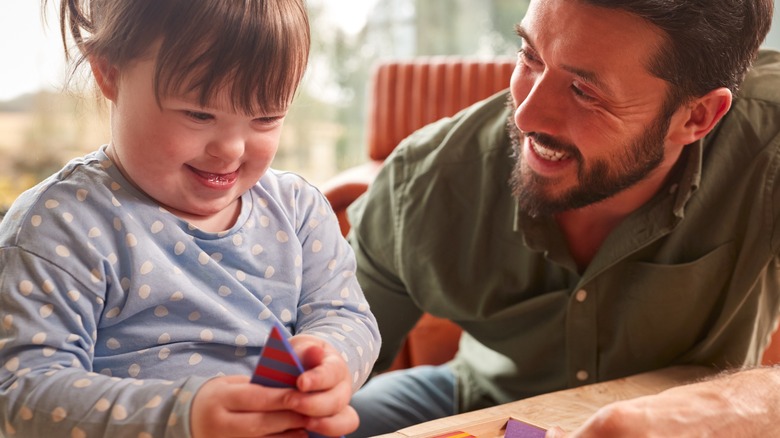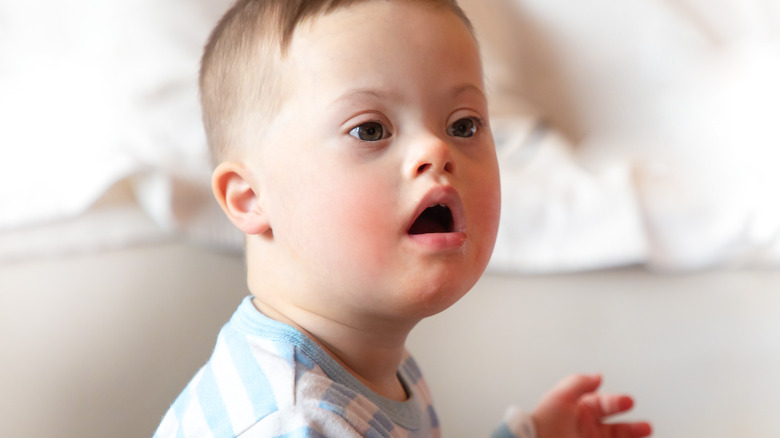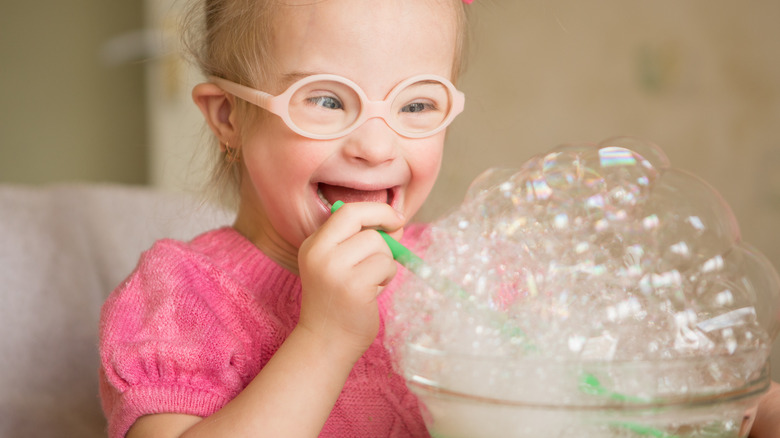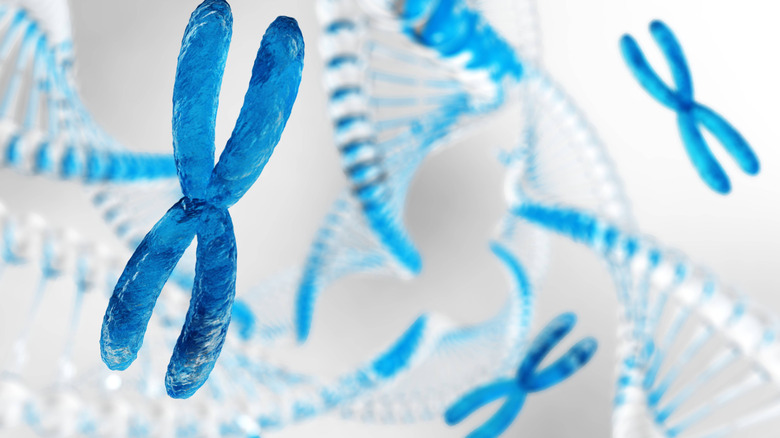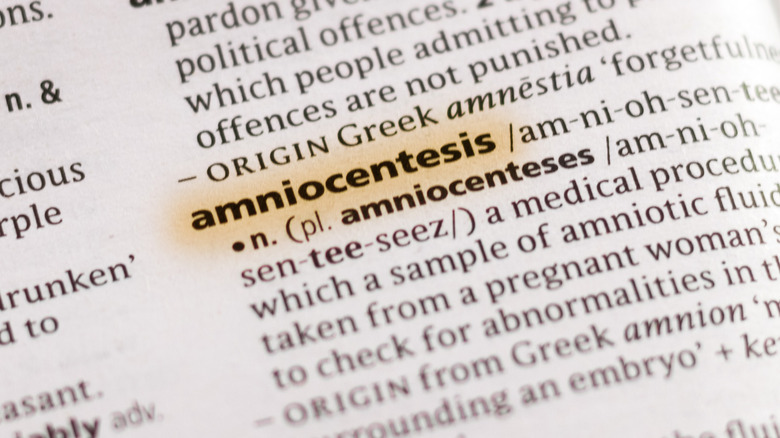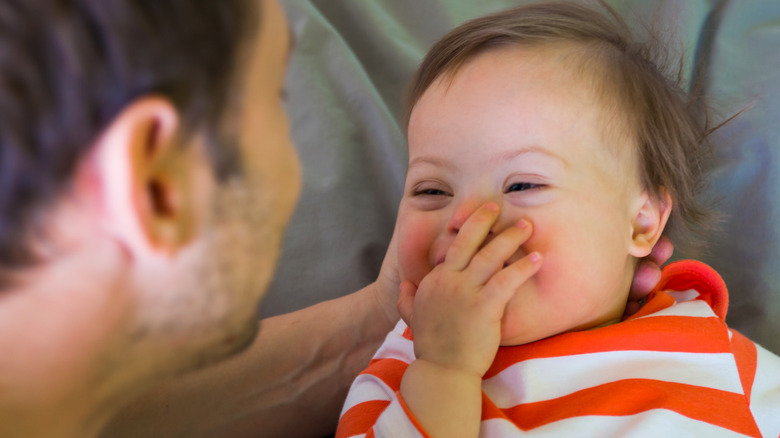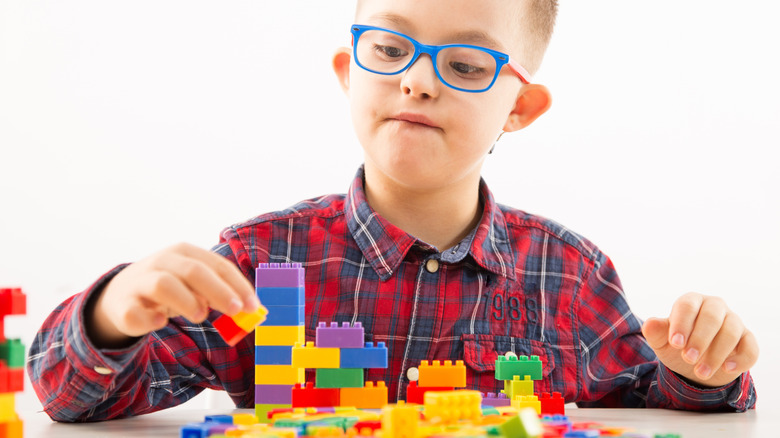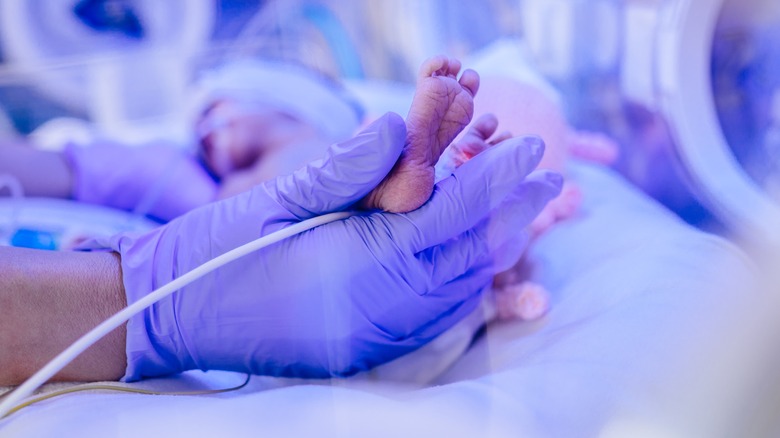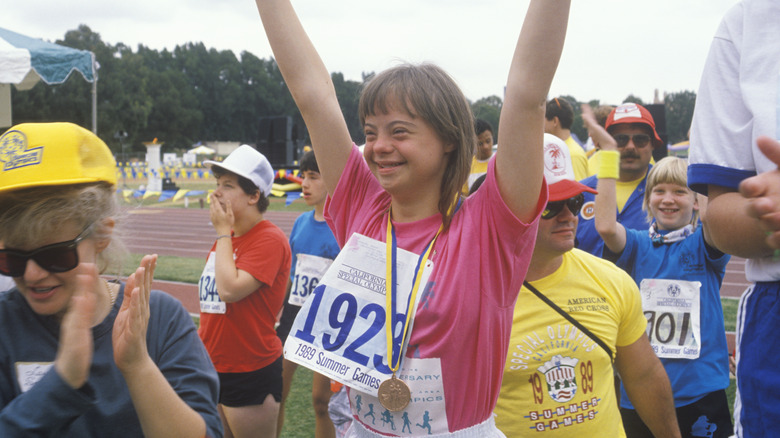Everything You Want To Know About Down Syndrome
A little something extra is one way to think of Down syndrome. That's because people with Down syndrome have 47 chromosomes rather than the usual 46, says the Centers for Disease Control and Prevention (CDC). Whether that teeny tiny chromosome is reproduced in all cells or only some cells, it plays a huge role in how the fetus is formed during pregnancy and how the person develops and functions after birth and throughout their lives (via the Mayo Clinic).
Down syndrome is the most common chromosomal condition in the United States, occurring in about one in every 700 children, says the CDC. While a risk factor for the condition is mothers older than 35, most Down syndrome babies are born to mothers who are less than 35, simply because there are more births among women of younger ages.
Most cases of Down syndrome are not inherited, per MedlinePlus. They are caused by a random event that occurs during the formation of the reproductive cells in the parent, with either an egg or sperm cell gaining an extra copy of chromosome 21. While researchers understand the relationship between Down syndrome and the extra chromosome, more research is needed to understand other factors that contribute to the condition.
People with Down syndrome were stigmatized well into the 20th century
Down syndrome was first acknowledged as a unique condition in 1866 by British physician John Langdon Down (via CBS News). However, the characteristics of the syndrome are depicted in figurines dating back to 1500 B.C., according to a 2011 study on the history of Down syndrome published in the Journal of Contemporary Anthropology. The earliest archaeological sign of Down syndrome was found in 1989, when the skeleton of a child that lived about 1,500 years ago was excavated from a medieval cemetery in France. It appears that people with Down syndrome weren't stigmatized back then, as the child's burial method was similar to other bodies in the cemetery.
Sometime between ancient and current times, stigmatization of people with Down syndrome sprung to life and persistently hung on. Prior to the 1960s, people with the condition were referred to as being mongoloid and most were institutionalized shortly after birth, says Healthcare Daily Online. Many died between infancy and early adulthood.
It wasn't until 1960, when the National Association for Down Syndrome was formed and "Down syndrome" became standard terminology, that society started making the gradual shift toward valuing people with Down syndrome. Still, as late as the 1980s, doctors in the United States were refusing to perform life-saving procedures — including feeding babies — on people with the condition. And civil rights protections were only awarded in 1990, with the signing of the Americans with Disabilities Act.
These are the common signs and symptoms of Down syndrome
Physical characteristics of Down syndrome are often recognizable at birth, including almond-shaped eyes, a flattened face and nose, and a small mouth with a tongue that may stick out (via the March of Dimes). Other characteristics include small hands, feet, and ears; a short neck; and a single line across the center of the hand.
Medical conditions that are common among people with Down syndrome include heart problems, gastrointestinal issues like constipation, thyroid abnormalities, sleep apnea, and hearing and vision problems, says the Cleveland Clinic. People with Down syndrome also may have autism, or develop Alzheimer's disease as they age. Per the Down Syndrome Society (as cited by the Cleveland Clinic), Alzheimer's disease develops in about 30% of people who have Down syndrome by the time they are in their 50s, and in about 50% of people in their 60s. Studies show that the extra chromosome that causes Down syndrome also contributes to the brain changes that affect people with Alzheimer's.
Learning and behavioral symptoms of Down syndrome may include delayed language and speech development, short attention span, poor judgment, and impulsive behavior (via the National Institutes of Health). While cognitive impairment is common among people with Down syndrome, the condition is rarely associated with severe intellectual disabilities.
There are three types of Down syndrome
The most common type of Down syndrome is trisomy 21 (nondisjunction), which results when three copies of chromosome 21 end up in the embryo instead of the usual two, says the National Down Syndrome Society (NDSS). That extra chromosome is then reproduced in every cell of the fetus as the embryo develops, resulting in a baby with Down syndrome.
Mosaicism, or mosaic Down syndrome, is the least common type of Down syndrome (via the Central Mississippi Down Syndrome Society). It occurs when some of the cells in the embryo contain the usual 46 chromosomes and some contain 47. A person with mosaic Down syndrome may have fewer characteristics of the condition, but that varies widely from person to person.
The third type of Down syndrome is known as translocation. That's when the total number of chromosomes in the cells is 46, but another full or partial copy of chromosome 21 attaches to another chromosome, causing Down syndrome characteristics.
Several factors increase your likelihood of having a child with Down syndrome
A mother's age plays a major role in the chances of having a child with Down syndrome, says Parents. If you're 25, your chances are one in 1,200. At 35, the risks increase to one in 350; by 40, it's one in 100; and at 45, it's one in 30.
Age 35 is considered the beginning of "advanced maternal age" (via Genome Medical). Preconception genetic testing of both potential parents may be recommended to make sure neither person is the carrier of a genetic condition. This noninvasive procedure, also known as carrier screening, can be performed on a saliva, blood, or cheek swab sample.
If it turns out that either the mother or both parents are carriers of the same genetic condition, there's an increased chance that their baby will be affected by the condition. There's usually no outward sign that you carry the potential for a genetic condition.
Screening for Down syndrome can be done during pregnancy
Prenatal screening using ultrasounds and blood tests can estimate the likelihood of a child having Down syndrome, and is a cost-effective, noninvasive way to determine whether further testing is needed (via Medical News Today). But it can't confirm the condition.
One screening option is a nuchal translucency test that's done at 11 to 14 weeks of pregnancy to measure the clear space in the folds of tissue behind the neck of the fetus. This abdominal ultrasound can detect whether the fetus has more fluid than usual at the back of its neck — a possible sign of Down syndrome, says Mount Sinai. A blood test of the mother also is done at this time and, together, the two tests can predict whether the baby may have Down syndrome.
Other screening tests, says Medical News Today, include a triple screen or quadruple screen, done at 15 to 18 weeks of pregnancy, to test the qualities of various substances in the mother's blood; an integrated screen, which combines the results of the first- and second-trimester blood and screening results; and cell-free DNA, a blood test that analyzes the fetal DNA that is present in the mother's blood. Genetic ultrasound, which is done at 18 to 20 weeks, combines an ultrasound with blood test results.
Diagnostic tests during pregnancy pose greater risks
Diagnostic tests during pregnancy can definitively tell if your baby has Down syndrome, says WebMD, but they have a small risk of leading to a miscarriage.
The tests, which check the baby's chromosomes for signs of Down syndrome, include amniocentesis, where a needle is inserted through your belly to extract a sample of the amniotic fluid that surrounds the fetus in the womb. The highest risk of miscarriage with this procedure is before 15 weeks of pregnancy, with the risk decreasing after 15 weeks.
Chorionic villus sampling (CVS) is another diagnostic test that has the advantage of being done at 10 to 12 weeks of pregnancy, rather than 15 to 20 weeks (via the University of California San Francisco Health). Guided by ultrasound, a tiny piece of tissue is removed from the placenta, either by a needle inserted through the mother's abdomen or a catheter through the cervix. The chromosomes in the tissue are then analyzed.
What to expect when you have a newborn with Down syndrome
If you had diagnostic testing during your pregnancy, you may know ahead of time that your baby has Down syndrome, and can prepare accordingly. If not, Dr. Jessica Morse, a neonatal-perinatal pediatric specialist at the University of Texas Southwestern Medical Center, offers some great tips in a blog.
A blood test is needed to confirm Down syndrome after birth, but characteristics such as flatter facial features are definite signs of the condition. Your baby also may feel sort of floppy. That's because babies with Down syndrome have low muscle tone, and their first two vertebrae may be unstable. Their head and neck often needs extra support.
Because babies with Down syndrome are at higher risk of a variety of health issues, they may require more tests after birth, as well as a longer hospital stay. And once you're headed home, you might need a specialized car seat, as a regular car seat poses hazards to babies with Down syndrome, including blockage of their airway. A car bed might be recommended so your infant can ride safely in a prone position, rather than sitting up, until their muscles become more developed.
Longer term, expect slower developmental rates if your baby has Down syndrome. Dr. Morse's chart of the developmental differences between babies with and without Down syndrome may help you adjust your expectations and celebrate your child's progress whenever it occurs.
Here's how to refer to Down syndrome and the people who have it
There's often confusion around what terms to use when talking about a person who has Down syndrome. While John Langdon Down is credited with first characterizing the condition, it's called Down syndrome, not Down's syndrome (via Down Syndrome Association of Wisconsin, Inc.), so skip the "apostrophe s." Dr. Down didn't have the condition and he didn't own it. Plus, Down syndrome should be referred to as a condition or syndrome, not a disease.
People don't "suffer from" Down syndrome, and they're not "afflicted" by it. They simply have it. And the terms "mental retardation" and "retarded" have been deep-sixed, thank goodness, in exchange for "intellectual disability" or "cognitive disability." The term "intellectually and developmentally disabled" is another acceptable term, says the Global Down Syndrome Foundation, and their favorite is "differently-abled." Nice!
Why not refer to people who have the condition as Down's babies or kids, or Down's people? Apply this to yourself for a moment and see how it feels, suggests renowned educator and inclusion specialist Patti McVay. Think of something you don't like about yourself and imagine that word preceding your name throughout your whole life: Fat Cathy, Clumsy Sam, Big Nose Dorothy. Not great for building self-esteem, right?
Ways to help kids with Down syndrome achieve their full potential
There's no cure for Down syndrome, but there are plenty of physical, behavioral, and educational therapies and services available in many communities to help children develop, learn, and function at their highest potential. And the earlier intervention begins the better, says the Boston Children's Hospital.
Therapies that may be helpful to children with Down syndrome include speech therapy, to improve the child's communication skills; occupational therapy to improve motor skills; physical therapy to increase muscle strength and mobility; and behavioral therapy to help the child with emotional and behavioral challenges.
Children under age three are usually eligible to receive services through state-run, federally mandated programs; and from age three to 21, the public school system should provide educational programs. Many children with Down syndrome can function and learn in a general education classroom, while others require a smaller classroom where one-on-one attention is provided.
Every child who has Down syndrome is different. Each has different potential, but those with mild intellectual disability are usually able to read, hold some type of job, and do things like take public transportation by themselves. Many graduate from high school, and some attend college classes. Some learn to drive, and are able to live independently (via WebMD), while others will need more support and may live at home with their families, in a house or apartment where some services are provided, or in a group home with other people who have disabilities.
The life expectancy for people with Down syndrome is gradually increasing
In the 1960s, children with Down syndrome typically lived until around age 10 (via the University of Pittsburgh Medical Center). By the 1980s, that age was up to 25, and today the average life expectancy is nearly 60 years and climbing, says Nationwide Children's Hospital. However, a 2015 study found that life expectancy varies depending on a person's race, with African American and other minority populations having significantly shorter lifespans. In fact, a study done from the Centers for Disease Control and Prevention (CDC) found that life expectancies of minority populations was nearly half that reported among non-minority populations.
A study published in the Journal of Pediatrics (via the National Library of Medicine) reported that very low birth weight is one possible explanation for increased mortality rates among newborns who have Down syndrome. In fact, the study found that babies with low birth weights had 24 times the risk of dying during the neonatal phase — infancy — than babies born within a normal weight range. And children born with congenital heart defects, which often accompany Down syndrome, were five times more likely to die during the postneonatal phase (up to age one) and to be at continued risk of mortality up to age 20. And that's not even figuring in the racial disparities that exist. So, while life expectancy is gradually improving, there's still plenty of room for improvement, and more research is needed (via Nationwide Children's Hospital).
Debunking a few myths about Down syndrome
There are numerous myths about Down syndrome, says the National Down Syndrome Society, so we'll just hit on a few of them here. First, the myth that people with Down syndrome are always sick. While they're prone to certain health conditions, advances in healthcare and treatment of those conditions are allowing many people with Down syndrome to lead healthy lives. The Special Olympics are one way they can participate in athletic activities and enjoy competing on a level playing field.
Second, the myth that it's okay to use the "r-word" if you don't really mean it. So wrong! It's never okay to use the word "retarded" in a derogatory context, or any context for that matter. It implies that the person with Down syndrome isn't competent, and that's hurtful.
And third, the myth that scientists know everything there is to know about Down syndrome is totally untrue. Researchers are still making big strides in learning how individual genes on chromosome 21 affect a person with Down syndrome, and they expect to be able to correct, improve, or prevent many of the health problems associated with the condition.
Resources are available to help families affected by Down syndrome
Your first reaction to having a child with Down syndrome may be grief, loss, and fear of the unknown, says KidsHealth. Talking to other parents who have kids with Down syndrome, and learning all you can about the condition and what to expect, may help you come to terms with your feelings and gain perspective — and even hopefulness — about the future.
A variety of organizations offer resources to help support people who have Down syndrome and their families (via the Cleveland Clinic). Good places to start include the National Down Syndrome Society and the National Association for Down Syndrome. Down Syndrome Pregnancy also offers excellent articles on preparing for the birth of a baby with Down syndrome.
According to the National Down Syndrome Society, studies exploring how a child with Down syndrome affects families have shown that, while families experience additional challenges, their sense of well-being is comparable to families without a child with Down syndrome. Researchers say one key to a family's ability to be resilient and thrive is the availability of individual, family, and community resources.

